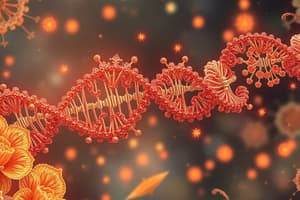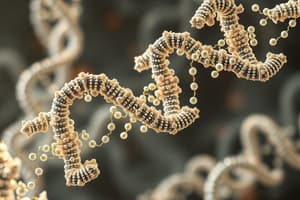Podcast
Questions and Answers
What is the primary function of RNA polymerase in transcription?
What is the primary function of RNA polymerase in transcription?
- To replicate DNA
- To modify mRNA after synthesis
- To synthesize RNA from a DNA template (correct)
- To degrade non-coding RNA
Which RNA polymerase is responsible for the synthesis of mRNA in eukaryotic cells?
Which RNA polymerase is responsible for the synthesis of mRNA in eukaryotic cells?
- RNA polymerase IV
- RNA polymerase I
- RNA polymerase II (correct)
- RNA polymerase III
Where does transcription occur in eukaryotic cells?
Where does transcription occur in eukaryotic cells?
- In the nucleus (correct)
- In the cytoplasm
- On the ribosome
- In the endoplasmic reticulum
What is the significance of the TATA box in eukaryotic transcription?
What is the significance of the TATA box in eukaryotic transcription?
Which statement accurately reflects the difference between eukaryotic and bacterial transcription?
Which statement accurately reflects the difference between eukaryotic and bacterial transcription?
Which sequence is commonly found in the promoter region of eukaryotic genes?
Which sequence is commonly found in the promoter region of eukaryotic genes?
What is a transcription unit?
What is a transcription unit?
What is NOT a component of transcription in eukaryotes?
What is NOT a component of transcription in eukaryotes?
What is the role of transcription factors in the transcription process?
What is the role of transcription factors in the transcription process?
Which part of the DNA sequence do several transcription factors recognize before RNA polymerase II binds?
Which part of the DNA sequence do several transcription factors recognize before RNA polymerase II binds?
What is the composition of the transcription initiation complex?
What is the composition of the transcription initiation complex?
In what direction does RNA polymerase synthesize RNA during elongation?
In what direction does RNA polymerase synthesize RNA during elongation?
How does the DNA double helix re-form during transcription?
How does the DNA double helix re-form during transcription?
What is the rate of transcription progress in eukaryotes?
What is the rate of transcription progress in eukaryotes?
Which of the following general transcription factors is not involved in the initiation of RNA polymerase II-dependent transcription?
Which of the following general transcription factors is not involved in the initiation of RNA polymerase II-dependent transcription?
What mechanism allows multiple RNA polymerase molecules to transcribe a single gene at once?
What mechanism allows multiple RNA polymerase molecules to transcribe a single gene at once?
What is the directionality of transcription in relation to the coding strand?
What is the directionality of transcription in relation to the coding strand?
What signal initiates the termination of transcription in eukaryotes?
What signal initiates the termination of transcription in eukaryotes?
Which enzyme is responsible for digesting the remaining RNA transcript during eukaryotic transcription termination?
Which enzyme is responsible for digesting the remaining RNA transcript during eukaryotic transcription termination?
What happens to the transcript in bacteria after termination of transcription?
What happens to the transcript in bacteria after termination of transcription?
What characterizes the sugar in RNA compared to DNA?
What characterizes the sugar in RNA compared to DNA?
In eukaryotic cells, where does RNA polymerase II bind to initiate transcription?
In eukaryotic cells, where does RNA polymerase II bind to initiate transcription?
Which of the following statements about RNA produced during transcription is correct?
Which of the following statements about RNA produced during transcription is correct?
How does termination of transcription differ between bacteria and eukaryotes?
How does termination of transcription differ between bacteria and eukaryotes?
What is the primary function of RNA splicing in the eukaryotic nucleus?
What is the primary function of RNA splicing in the eukaryotic nucleus?
What are the noncoding segments of nucleic acid called that lie between coding regions?
What are the noncoding segments of nucleic acid called that lie between coding regions?
How many nucleotides are typically required to code for a protein of 400 amino acids?
How many nucleotides are typically required to code for a protein of 400 amino acids?
What elements indicate the start and end of each intron during RNA splicing?
What elements indicate the start and end of each intron during RNA splicing?
What complex is primarily responsible for carrying out the removal of introns during RNA splicing?
What complex is primarily responsible for carrying out the removal of introns during RNA splicing?
What happens to introns after they are removed during RNA splicing?
What happens to introns after they are removed during RNA splicing?
What is formed after the splicing process is completed?
What is formed after the splicing process is completed?
Where does mature mRNA go after processing in the nucleus?
Where does mature mRNA go after processing in the nucleus?
What role does RNA play in the assembly of proteins?
What role does RNA play in the assembly of proteins?
Which process is primarily responsible for synthesizing RNA from DNA?
Which process is primarily responsible for synthesizing RNA from DNA?
What distinguishes eukaryotic gene expression from prokaryotic gene expression?
What distinguishes eukaryotic gene expression from prokaryotic gene expression?
Which of the following statements is true regarding small RNAs?
Which of the following statements is true regarding small RNAs?
How do prokaryotic mRNA molecules differ from eukaryotic mRNA molecules?
How do prokaryotic mRNA molecules differ from eukaryotic mRNA molecules?
What is the result of introns and exons differing between genes?
What is the result of introns and exons differing between genes?
Which of the following best defines a gene?
Which of the following best defines a gene?
What is the main catalytic role of RNA exemplified by telomerase?
What is the main catalytic role of RNA exemplified by telomerase?
Flashcards are hidden until you start studying
Study Notes
Versatility of RNA
- RNA acts as a scaffold for protein assembly, exemplified by the signal recognition particle.
- RNA-protein interactions can modulate the catalytic activity of proteins like telomerase.
- Certain RNA molecules can have catalytic functions.
- Small RNAs play a direct role in regulating gene expression.
- RNA can function as hereditary material, essential in biological inheritance.
Gene Expression
- Gene expression connects inherited DNA to specific traits via RNA synthesis, leading to protein production.
- Involves two main stages: transcription (RNA synthesis) and translation (protein formation).
- A gene consists of a DNA sequence coding for a functionally active molecule.
- Eukaryotic genes include coding exons and noncoding introns, with variable numbers and sequences.
Prokaryotic vs. Eukaryotic Gene Expression
- Eukaryotic gene expression occurs in the nucleus (transcription) and cytoplasm (translation); prokaryotes conduct both in the cytoplasm.
- Eukaryotes possess monocistronic mRNA, encoding a single polypeptide; prokaryotes feature polycistronic mRNA, capable of coding multiple proteins.
- Eukaryotic genes contain introns and exons; prokaryotic genes are largely uninterrupted.
- Approximately 98% of human DNA is non-coding; prokaryotic genomes often exceed 95% coding sequences.
Molecular Components of Transcription
- Key components include RNA polymerase, promoter regions, transcription units, and termination sequences.
RNA Polymerase
- Enzyme facilitating transcription; synthesizes RNA in the 5' to 3' direction.
- Unlike DNA polymerases, RNA polymerases do not require a primer to initiate synthesis.
- Eukaryotic cells contain distinct RNA polymerases:
- RNA polymerase I: synthesizes rRNAs for ribosomal function.
- RNA polymerase II: produces mRNA and miRNAs.
- RNA polymerase III: creates tRNAs.
Eukaryotic Promoter
- Promoter regions are DNA sequences where RNA polymerase binds to start transcription.
- The TATA box is a common sequence located 15-30 base pairs upstream of the transcription start site.
- Additional elements such as CAAT and GC boxes can be necessary for promoter activity.
Transcription Unit
- Defined as the DNA sequence from the transcription start site to the stop site.
Stages of Transcription
- Includes three phases: initiation, elongation, and termination.
Initiation
- Begins at the transcription start point in the promoter; transcription factors assist RNA polymerase binding.
- A transcription initiation complex forms after all necessary transcription factors and RNA polymerase II are attached.
- Eukaryotic transcription factors include TFIIA, TFIIB, TFIID, TFIIE, TFIIF, and TFIIH.
Elongation
- RNA polymerase unwinds DNA and synthesizes RNA in a transcription bubble by breaking hydrogen bonds.
- The template strand of DNA is used to form RNA, which exits the transcription bubble as it is synthesized.
- Transcription occurs at a rate of about 40 nucleotides per second in eukaryotes, producing RNA that is complementary to the coding strand.
Termination of Transcription
- The mechanism diverges between bacteria and eukaryotes.
- In bacteria, transcription continues through a terminator sequence, which signals RNA polymerase to detach upon reaching it.
- In eukaryotes, RNA polymerase II transcribes a polyadenylation signal (AAUAAA) leading to pre-mRNA processing via protein binding.
RNA Splicing
- Vital stage of RNA processing in the nucleus involves removing introns from the pre-mRNA to form mature mRNA.
- Average transcription unit length is about 27,000 nucleotides, while typical proteins require only about 1,200 nucleotides.
- Introns: noncoding segments between coding regions; exons: sequences that are expressed and translated.
- RNA polymerase II transcribes both introns and exons; only exons appear in the cytoplasmic mRNA.
Pre-mRNA Splicing Mechanism
- Involves splice site sequences marking the start (GU) and end (AG) of introns.
- A spliceosome, made of proteins and small RNAs, performs splicing by binding splice site sequences.
- After intron removal, exons are ligated to form the final mRNA, which exits the nucleus through nuclear pores.
Studying That Suits You
Use AI to generate personalized quizzes and flashcards to suit your learning preferences.




